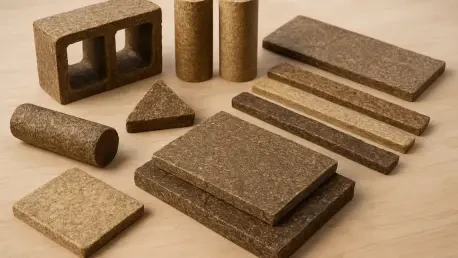Across tropical coastlines from Brazil to the Caribbean, a mounting environmental crisis has emerged as sargassum seaweed washes ashore in overwhelming quantities, transforming pristine beaches into toxic, odorous wastelands. This algae, once a harmless feature of the Sargasso Sea, now threatens tourism, fishing industries, and marine ecosystems by releasing harmful gases like ammonia and methane as it decomposes. For years, the primary response has been to haul this seaweed to landfills, a practice that exacerbates waste management challenges without offering any beneficial reuse. However, recent research presents a groundbreaking alternative: transforming this problematic seaweed into sustainable building materials. This innovative approach not only tackles an ecological disaster but also paves the way for greener construction practices, turning a nuisance into a valuable resource for the future of infrastructure development.
Addressing an Environmental Crisis with Innovation
The surge of sargassum seaweed along tropical shores has grown into a significant environmental and economic burden, disrupting livelihoods and ecosystems with its toxic decay. Disposing of this algae in landfills has long been the default solution, yet it fails to address the root issues of waste accumulation and resource depletion. A pioneering study from the University of São Paulo, led by Professor João Adriano Rossignolo, offers a compelling shift in perspective by proposing the use of sargassum as a raw material for construction. By integrating this seaweed into various building components, the research seeks to mitigate the crisis at its source while providing an eco-friendly alternative to traditional materials. The potential impact is twofold: reducing the strain on waste management systems and curbing the environmental footprint of the construction industry, which often relies on resource-intensive processes.
Beyond merely addressing disposal, this initiative reframes sargassum as a viable asset in sustainable development. The research focuses on incorporating the seaweed into ceramic clay mixtures, resulting in lighter and more energy-efficient materials suitable for modern building needs. Applications range from lightweight concrete aggregates to insulating slabs and even gardening products. This versatility highlights how an otherwise burdensome waste product can be reimagined to serve practical purposes. Additionally, the approach aligns with broader sustainability goals by minimizing reliance on finite resources like limestone, which are commonly used in construction. As the global push for greener practices intensifies, such innovations underscore the importance of rethinking waste as a resource, offering a blueprint for tackling similar environmental challenges worldwide.
Revolutionizing Construction with Sargassum-Based Materials
Delving into the technical aspects, the research reveals that blending sargassum into clay at concentrations of 20% to 40% significantly reduces the weight of the resulting materials, making them ideal for lightweight construction. These mixtures undergo shaping through extrusion and are fired at high temperatures ranging from 800°C to 1,000°C, using both conventional and microwave ovens. Notably, samples processed in microwave ovens exhibit superior strength and densification due to a refined internal structure, meeting rigorous industry standards across all tested conditions. Comprehensive tests on factors like shrinkage, water absorption, porosity, density, and mechanical strength further validate the durability and practicality of these algae-infused materials. A life cycle assessment also demonstrates a reduced ecological footprint compared to traditional expanded clay, positioning this as a promising sustainable alternative.
Expanding on the potential applications, the study explores additional uses of sargassum in construction beyond ceramics, such as in particulate panels for furniture and fiber cement tiles. In panels, up to 30% sargassum content has been successfully incorporated, while in tiles, sargassum ash completely replaces limestone without compromising durability or performance. These findings not only adhere to current standards but also enhance material properties, showcasing the adaptability of this seaweed as a raw ingredient. Such advancements reflect a growing trend in scientific communities to leverage organic waste for addressing resource scarcity and environmental degradation. By aligning with circular economy principles, these developments encourage industries to adopt sustainable practices, potentially transforming how building materials are sourced and produced in the long term.
Paving the Way for a Sustainable Future
Reflecting on the broader implications, the integration of sargassum into building materials marks a pivotal moment in balancing environmental challenges with industrial innovation. This research demonstrates that what was once considered a coastal nuisance can be reimagined as a cornerstone of eco-friendly construction, reducing dependency on non-renewable resources. The successful application in ceramics, panels, and tiles underscores the material’s versatility and practicality for real-world use. Advanced techniques like microwave sintering play a crucial role in optimizing outcomes, proving that technology can bridge the gap between sustainability and performance. This initiative sets a precedent for how waste management and infrastructure needs can converge into cohesive solutions.
Looking ahead, the path forward involves scaling these findings into widespread adoption within the construction sector. Stakeholders must prioritize investment in processing technologies and pilot projects to test sargassum-based materials in diverse building contexts. Collaboration between environmental scientists, engineers, and policymakers will be essential to refine standards and ensure scalability. Additionally, raising awareness among coastal communities about the dual benefits of clearing sargassum and repurposing it could foster local support for such initiatives. By building on this research, the industry can move toward a future where sustainable materials are the norm, not the exception, ultimately reshaping urban development with an eye toward environmental stewardship.









